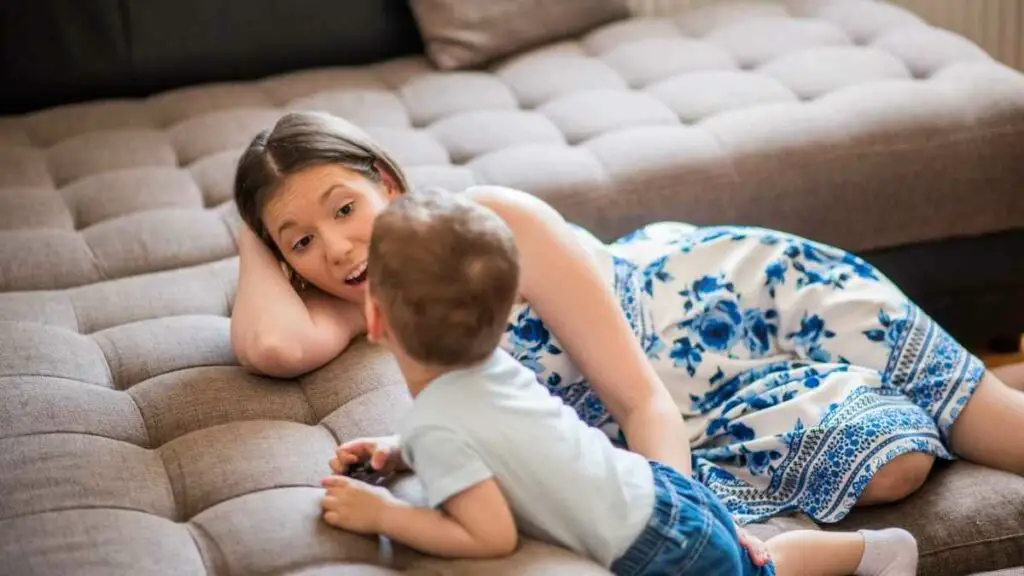In the complex, ever-evolving world of child-rearing, discipline stands as a cornerstone, a contentious topic riddled with countless ideas and philosophies.
The simple question, “Does punishment really work for children?” becomes multi-layered, teeming with considerations on child psychology, physical and emotional health, and the intrinsic value of alternatives to punishment.
We begin by looking at how children understand punishments and consequences. We’ll explore the different techniques parents use to discipline their children, not to judge them but to understand how effective they are and what impact they might have. We’ll also look at the emotional and mental well-being of children, which is often overlooked, and how harsh punishments can have negative effects. We’ll use simple language and short sentences to make the text easy to understand. Finally, we’ll make sure to put the most important information first and to use the active voice to make the text clear and direct.
Our next step is to explore different approaches to discipline that focus on empathy, communication, and positivity. Our goal is to provide practical steps for parents and caregivers to create a nurturing and effective disciplinary system at home. By combining theory with practice, we hope to offer a comprehensive overview to help you develop a respectful and adaptable discipline strategy for your children.
Understanding Child Psychology
Master the ABCs of Child Psychology: Empowering Parents to Thrive
Ah, parenting, the world’s oldest profession in all its complexity! In the heart of every parent beats a desire to understand their little ones better. Diving into child psychology can sometimes feel like wandering in a labyrinth, given the many intricacies involved. Let’s unravel this complex tapestry and look honestly at what you, super moms and dads, need to know to navigate your children’s emotions gracefully and sensitively.
First and foremost, let’s wrap our heads around a key building block of child psychology – developmental stages. Child psychologist Jean Piaget laid down some ground rules that help parents gain insight into their children’s brains and hearts. Each of the four stages of cognitive development has associated thoughts, feelings, and behavior patterns that children typically display. Understanding these stages can help parents appreciate where their child is developmentally and respond appropriately to their needs.
Next, let’s unpack another crucial aspect – emotional development. From the first cry to the first ‘I love you,’ your child’s emotions evolve rapidly. Emphasizing emotional intelligence from an early age is a significant factor in their success as adults. Create an atmosphere where emotions are openly identified, valued, and expressed. This practice helps children manage emotions healthily, fostering resiliency and contributing to their overall well-being.
Coming up, we have the fine art of communication. Ever wondered why children ask ‘why’ so often? Their curiosity fosters critical thinking. Avoiding dismissive answers like “Because I said so!” can pay dividends. Instead, encourage questioning by rewarding their curiosity with thoughtful and age-appropriate responses. This approach nurtures their cognitive development, helps build self-esteem, and forms a reliable bridge between you and your little one.
-

Bold Male Pride – Baseball Trucker Cap Celebrating Masculinity
£18.00 Select options This product has multiple variants. The options may be chosen on the product page -

Dad Bod Appreciation Gift Mug
£14.00 Add to cart -

Dad Bod, Bad Jokes Structured Baseball Cap
£22.00 Select options This product has multiple variants. The options may be chosen on the product page
Remember that precious bonding time during your child’s first months? Those endless rounds of peek-a-boo and your lullabies weren’t just for fun. They laid the foundation of attachment theory – a cornerstone of child psychology. Strong emotional and physical attachment to at least one primary caregiver is essential to a child’s personal, emotional, and social development. Nurturing this bond ensures your child matures into a confident, compassionate, and secure individual.
Lastly, let’s highlight the importance of modeling behavior. Children are fantastic imitators, and they’re keen to pick up and mirror your behaviors, attitudes, and even your coping mechanisms. Remember, your actions will always speak louder than your words. So arm yourself with conscious decision-making and positive behaviors to demonstrate the attitudes and actions you hope to see in your child.
So there we have it, parents! A handy checklist of essential elements of child psychology to guide you on this wild journey of raising humans. As you decode your child’s world, remember that the warmth, understanding, and love you provide while keeping these pointers in mind shall always yield the best results. Happy parenting, super moms and super dads! Each moment spent understanding your child is a step towards building stronger, happier, and healthier family relationships.

Different Forms of Punishments
The Reality of Parental Punishments: Understanding Their Influence on Children
Children are constantly learning and exploring their surroundings which can, at times, lead to misbehavior. As parents, disciplining these misbehaviors becomes a crucial part of the upbringing process. However, there’s a thin line between healthy discipline and harmful punishment that requires delicate navigation. It’s important to understand the types of punishments often used by parents and the potential effects they may have on children.
Commonly used punishments include time-outs, revoking privileges, or chores as a consequence. A prevalent method includes giving ‘time-outs’ to help children understand their wrongdoings. This method can be quite impactful if implemented correctly, allowing them a moment to think about their actions. But if ‘time-outs’ are associated with shame and isolation, it may result in feelings of anxiety and loneliness in a child.
Revoking privileges, like play-dates, internet access, or television time, is another usual punishment technique. While this method could help children realize the consequences of their actions, it could also lead to enhanced resentment if they feel the punishment is unjust.
Sometimes, parents resort to assigning chores as a consequence. While chores can teach responsibility, if used as a punishment, they may instill negative connotations toward necessary life skills.
Physical punishment, on the other hand, is an age-old method that has been seriously debated over the years. Studies suggest that physical punishment may result in adverse consequences such as increased aggression, antisocial behavior, and decreased cognitive ability, to name a few.
With this understanding of the types of punishments and their potential effects, what are the alternatives?
Parents might opt for a ‘time-in’ instead of a ‘time-out’. This involves sitting with the child, helping them understand why their behavior was wrong, and fostering an environment of open dialogue.
Natural consequences are another effective method. Instead of artificial punishments, let the consequences of the child’s actions teach them a lesson. For instance, if a child refuses to wear a jacket, they’ll eventually feel cold and understand the importance of wearing one.
Utilizing rewards for good behavior can also help. This way, we encourage and reinforce the child’s positive actions more than focusing on detrimental behaviors.
Last but not least, adopting healthy communication is vital. Rather than resorting to yelling, which can instill fear, use a calm and firm tone. Children require consistent reminders of what’s appropriate and what’s not.
Each child is unique and individual in their understanding of the world around them. Adapting and personalizing our discipline strategies while focusing more on education, encouragement, and empathy could create a healthier parent-child dynamic and more positive outcomes for the child’s emotional and psychological well-being in the long run.
Remember, discipline is not about punishment but about understanding right and wrong in a supportive, loving environment.

The Impact of Punishment on Emotional and Mental Health
Exploring the Impact of Punishment on a Child’s Emotional and Mental Health
Punishment has always been a hot topic in the parenting world. Everywhere you look, you’ll find contrasting ideas and opinions about what methods are effective or too harsh. One thing all parents can agree on is that discipline plays a critical role in our children’s upbringing, helping teach them about boundaries, personal ethics, and societal norms.
Parents commonly resort to punishments like timeouts, revoking privileges, or assigning extra chores. Each of these tactics is designed to instill a lesson or present a consequence for the child’s actions. However, the effect of these punishments reaches far beyond a short-term disciplinary action, impacting a child’s emotional and mental health in various ways.
Time-outs, for example, push a child into isolation, potentially leading to feelings of abandonment and causing harm to their self-esteem. The child might also associate solitude with punishment rather than a chance for self-reflection. Moreover, when children have their privileges revoked – like playtime or TV hours – it can engender resentment and anger instead of remorse or understanding of their actions. Assigning extra chores might also stray from its disciplinary intention and create a negative association with household responsibilities.
Physical punishment has always been subject to significant debate due to several adverse effects it can have on children. Long-term effects can include aggression, antisocial behavior, and mental health problems. It’s crucial that we, as parents, consider these potential implications when contemplating disciplinary methods.
So, how do we strike a balance between necessary discipline and maintaining our children’s emotional and mental well-being? One effective solution could be to implement alternatives to traditional punishments.
One such alternative is a “time-in.” In contrast to a time-out, a time-in lets a child sit with an adult who can guide them through their feelings and teach them coping mechanisms. This method turns a potentially disastrous situation into a teachable moment. It creates a supportive environment that encourages open communication, allowing the child to understand their emotions better and learn how to regulate them appropriately.
Employing natural consequences can also prove to be beneficial. Letting our children experience the reasonable consequences of their actions, we help them understand the cause-and-effect relationship. This method promotes personal responsibility and independence.
Moreover, positive reinforcement for good behavior encourages children to repeat those actions. Rewards don’t always have to be materialistic; verbal praise or extra playtime can do the trick. Remember that each child is individual and unique. What works for one might not necessarily work for another.
Healthy communication is paramount. Ensure the child understands why they are disciplined and how to rectify their behavior. Rather than having them fear punishment, allow discipline to play its intended role – a method of teaching and understanding.
In essence, discipline should always be exercised in a loving and instructional environment. As loving parents, our primary goal is to guide our children toward becoming responsible, compassionate individuals who make mindful choices. By considering their emotional and mental health while determining disciplinary methods, we align our lessons with our love for them. After all, our intent is not to control our children but to help them develop control over their own lives.

Alternative Disciplinary Strategies
Disciplinary Strategies Beyond Punishment: Guiding Children with Compassion and Understanding
Welcome, parents! You’ve embarked on the beautiful journey of nurturing young minds. Along with all the wonder and love, it also involves understanding the fine balance between imparting discipline and promoting emotional well-being. You’ve already learned about common forms of punishment and their potential impact on a child’s mental health. It’s heartening to see the growing awareness amongst parents about finding alternative methods of discipline that place understanding and compassion at the forefront. Let’s dive right into two such methods and their positive effects!
An important and effective strategy is using “time-ins” instead of the commonly known “time-outs”. This approach helps keep calm and composure, which is invaluable in de-escalating conflicts. Unlike a time-out, where a child may feel isolated during emotional distress, a “time-in” involves staying with the child, reassuring them, and discussing their emotions. This improves their emotional intelligence and enables them to understand their feelings.
Natural consequences offer another merit-filled option. It’s a fantastic way of letting them learn and grow from their actions without feeling punished. For instance, if a child refuses to wear their coat in cold weather, they will feel chilly, encouraging them to wear it next time. It’s important to ensure the consequences are safe and appropriate for their age.
These techniques naturally shift focus towards rewarding good behavior. The power of positive reinforcement should not be underestimated. From verbal praise to special treats or additional privileges, these are immensely effective methods of motivating children and promoting positive behavior.
Open, healthy communication is the bedrock of all these strategies. Kids can often feel misunderstood, so taking their viewpoints into account, asking questions, and affirming their feelings can reassure them. This will help build a stronger parent-child connection and uphold mutual respect.
Each child, distinct and individual, requires a unique approach to discipline. What works for one may not work for another. Adapting to each child’s needs is not an easy task, but it’s a worthwhile effort in facilitating their emotional and mental well-being.
The aim of discipline isn’t to punish but to guide our children to become responsible, compassionate individuals. As parents, we don’t just want them to understand right from wrong but also why something is right or wrong. Raising them becomes an exercise in growing with them, shaping our understanding and approach, and leading by example. By using loving, understanding strategies, we can build a stronger, kinder generation.

Implementing an Effective Discipline Strategy at Home
When disciplining our little ones, it’s important to remember that no “one-size-fits-all” solution exists. Every child is wonderfully unique, and their discipline strategy should reflect this. Consider your child’s personality, learning style, and communication preferences when planning. Understanding what makes your child tick is the first step in tailored, effective discipline.
One of the critical elements to consider is the adverse effects of punishment-based approaches. While punishment might result in temporary obedience, it can have harmful long-term impacts, such as reducing a child’s self-esteem or leading to secretive behavior. This doesn’t mean we should let inappropriate behavior slide, but as responsible parents, we need to guide rather than just punish.
Shifting away from traditional punishments like time-outs, revoking privileges, or assigning additional chores, consider positive discipline techniques. One such approach is introducing “time-ins” instead of time-outs. A “time-in” encourages a child to reflect on their behavior while engaged in a calming activity or conversation.
Implementing natural consequences as a discipline strategy can also be helpful. A natural consequence happens naturally due to the child’s behavior, like having to clean up spilled milk or getting cold when they don’t wear a coat. It’s a practical method for helping children understand the consequences of their actions rather than enforcing harm as punishment.
One of the most powerful forms of discipline is positive reinforcement, recognizing and rewarding good behavior to encourage more of the same in the future. Think about the last time your child did something that made you proud: Did you express your pride and shower them with praise? If we focus on cultivating positive traits and behaviors rather than solely punishing the negative ones, we set the stage for a comfortable, secure learning environment.
Remember, the goal isn’t to inflict embarrassment or unease while disciplining your child; rather, it’s to cultivate understanding in a loving environment. It’s essential for the disciplinary process to include healthy, open communication, treating our children as individuals who can learn from their mistakes and make better choices in the future.
It’s important to treat each child as an individual who can learn from their mistakes and make better choices in the future. To achieve this, it may take time and patience to implement effective discipline strategies. The result will be a home environment where discipline serves as a teaching moment instead of a punishment.

Conclusion
To truly nurture the potential in our children, a paradigm shift is often necessary, moving away from traditional forms of punishment towards more empathetic, informed approaches. Understanding the child’s psychology and respecting it forms the best foundation for any disciplinary measures.
A keen eye should be kept on the child’s mental and emotional health, a factor sometimes overshadowed by the immediacy of behavioral correction. Embracing alternatives to punishment, like open communication and positive reinforcement, has shown significant improvements in child behavior and emotional growth. Finally, implementing an effective discipline system is beneficial not only for orderly behavior but also for fostering a deep sense of respect, mutual understanding, and emotional maturity in children.
One size will never fit all, but with these insights, caregivers can strive for a tailored, balanced, and nurturing approach to discipline. Let’s mold, not punishment, but guidance and understanding, into the new norm for child discipline, engendering an environment where our children can thrive.





